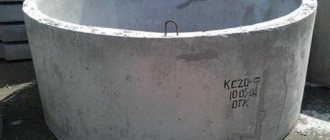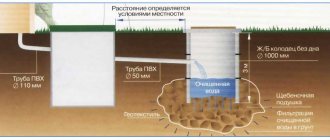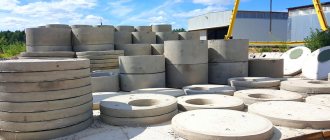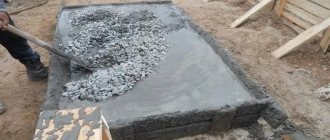Concrete rings make the installation of any well as easy as possible. The products are varied in characteristics, and it is important to know the dimensions and weight of the 1 m reinforced concrete ring so as not to make a mistake when choosing. We understand where and how these structural elements are used, what features and parameters they have.
The private sector cannot do without reinforced concrete products Source vdoske.in.ua
In which wells are they used?
Rings are needed to strengthen the walls of wells for various purposes. With their help, specialized engineering problems are solved, so the weight of the well ring is taken into account in the calculations. Reinforced wells are divided into the following types:
- Drainage . Storage systems help drain water during rainstorms, melting snow and floods.
- Sewer . Local septic tanks of various types, in which the rings form the walls of the tank or become a protective cement casing.
- Drinking wells and boreholes . They prevent walls from crumbling, maintain water purity, and allow the installation of pumping equipment.
- Observations . They provide safe access and are designed to control any equipment (pump, cables, valves and valves). Widely used on heating and cable mains, water and gas networks.
- Telephone . A variety of inspection reinforced concrete structures. They have a special shape and are needed for installation, pulling, and testing communication cables.
Rings and additional elements in the finished product warehouse Source yandex.net
How to find out the volume of a ring?
Method number 1 - find out her finger size using your own
- put the jewelry on all the way, remember the place where it fits tightly (to be sure, mark it with a pen);
- measure the girth with a thread or strip of paper;
- using a ruler, calculate the result in millimeters and divide by 3.14;
- the resulting number is the SAME number on your girlfriend’s finger.
Interesting materials:
What are the pineal gland and the diaphysis? What are epithets and metaphors examples? What is the Age of Pisces? What is ERC-20? What is a pop symphony orchestra? What is a standard in physics? What is the etiology and pathogenesis of the disease? What is Eurolighting? What is Europost? What is a factory in programming?
Characteristics
The ease of use and service life are affected by the following characteristics of concrete rings:
- Material . The structures are made from two types of raw materials. The classic option is concrete products marked M200-M500, reinforced with a welded lattice made of steel rod with a diameter of 6-10 mm. The second type is made from polymer-sand mixtures with improved strength and service life.
- For molding, a split vibroform or a stationary vibropress is used. Strong vibration helps to compact the material and create a solid part. After manufacturing, the rings are left to gain strength at the site of formation or placed in a steaming chamber for the same purpose.
- Dimensions . They are varied enough to be suitable for use in different projects. The standard height of popular products is 90-100 cm, wall thickness varies between 8-12 cm, diameter - 70-200 cm. There are designs of non-standard sizes for highly specialized tasks, individual production is possible.
Ring sizes are determined by three parameters Source v-srok.ru
- Weight . Without taking it into account, it is impossible to make calculations when designing, transport rings and assemble a structure from them. The weight of a 1 m reinforced concrete ring is different for each brand and depends on the dimensions: height, internal diameter, wall thickness, as well as the type of concrete.
- Construction type . Straight products with smooth edges are connected using cement mortar. Locking versions have a ring-shaped projection on one side that fits into a notch on the bottom. The locking connection turns out to be more reliable, the probability of displacement due to soil pressure tends to zero.
Do-it-yourself sewerage installation in a private house from concrete rings
The construction of a system of concrete rings, like any other sewer system, is carried out in stages.
The order of work is as follows:
- selection of a construction scheme;
- calculation of the capacity of the well taking into account the number of residents;
- choosing a suitable location for installing a septic tank;
- formation of a pit of the required size in accordance with calculations;
- installation of concrete rings;
Installation diagram of a septic tank made of concrete rings
- supply of pipe system;
- sealing seams between parts and joints;
- falling asleep of the structure.
Calculation and selection of a sewerage scheme made of concrete rings
A sewerage system based on concrete rings may include a septic tank with one, two or three chambers.
If a small number of people live in a house, it is better to choose a single-chamber structure for construction work, including a drainage well and a sump. Two-chamber systems are used when the house has a large amount of plumbing equipment, for example, a bathtub, sinks, toilet, washing machine, dishwasher, etc. In this case, the sewage system will consist of two containers and a drainage well.
Septic tank made of four concrete rings
The scheme may also include placement points for concrete trays for storm drainage, which are installed around the perimeter of the building’s blind area and in other problem areas where liquid can accumulate after heavy rainfall. This system will protect the topography of the site and the foundation part of the building from erosion by water.
The optimal design should take into account all the calculations necessary for comfortable use, in particular, the capacity of the well. This indicator depends on the daily water consumption of the residents of the house. The average amount of fluid consumption per person per day is about 150-200 liters. To calculate the optimal volume of a septic tank, this figure must be multiplied by the number of people living in the house on a permanent basis. To the result you need to add 20%, which will cover unplanned overruns and storm sewer drains.
Please note! According to building codes, a septic tank with an optimal volume must accommodate wastewater consumed within three days.
Installation diagram of septic tanks made of two concrete rings
To find out the number of rings required for the manufacture of a septic tank, you need to divide the total volume of the septic tank by the volume of the concrete product.
Preparing a site for the construction of a sewer system for a private house made of concrete rings
After the sewerage diagram has been drawn up and calculated, a location for installing the well is selected.
It is worth considering certain requirements:
- the minimum permissible distance between the house and the septic tank is 10 m;
- the level of groundwater movement should lie below the mark where the bottom of the well will be located;
- The minimum permissible distance between the source of drinking water and the septic tank is 50 m.
Preparing the site for sewerage construction
The construction area must be cleared of debris and stones. Next, a pit is dug, the size of which can accommodate a drainage well and a septic tank chamber with a margin of 30 cm on each side. In those places where storage chambers will be installed, concrete should be poured. Thus, the penetration of waste liquid into the soil and its contamination is prevented. Then it is necessary to form a drainage layer in the form of a sand cushion. Recommended thickness – 30-50 cm.
As an alternative to concreting, concrete rings equipped with a solid bottom can be used. These products will protect the surrounding soil from runoff pollution. Under the drainage well you need to form a cushion consisting of gravel, crushed stone and sand. Its minimum thickness is 50 cm.
Supply of pipes to the sewerage system
Advantages and disadvantages
Reinforced concrete rings are an indispensable element of construction with the following advantages:
- Long service life . Standard industrial rings are designed to last 50 years. In fact, the average service life is longer: wells built more than 60-70 years ago are currently functioning.
- Wide range of sizes.
- Installation is simple due to the correct geometric shape. You can quickly install a sewer or water supply system.
Installation of wells for a septic tank Source pinimg.com
See also: Catalog of companies that specialize in water supply, sewerage and related work
- Structural rigidity . Wells can be installed on any soil, including problematic (unstable) soil.
- Reliability of operation . The weight of the well ring ensures high structural strength
- Reliability of the design . If the installation technology is followed, the seams fit tightly and become airtight.
- High quality is pleasantly correlated with an affordable price.
The large weight of the ring ensures its strength, but it also causes the following disadvantages:
- Delivery and installation will require additional costs. You cannot do without the services of special equipment.
- If the load on the structure is higher than the calculated one , cracks and chips may form, and the tightness will be compromised.
For loading and unloading you need a crane. Source ibud.ua
Types of products
Ring is a conditional name; modules for wells, septic tanks or horizontal drifts for laying communications can have a cross-section different from the ring-shaped one. For example, a rectangular (square) box.
When creating wells, wall rings are used: monolithic, without any perforation. They can withstand high pressures: external from the soil and internal, filling such wells with water. Rings can be classic round or square in cross-section (these are used for installing a cellar). On the contrary, drainage rings have walls that are perforated. To prevent the elements from shifting relative to one another, locks are made at the ends of some - when the technological protrusion in one exactly coincides with a similar-shaped depression in the other.
Marking according to GOST: types of rings
All reinforced concrete products are marked in accordance with GOST standards. It consists of an alphabetic and digital part, informs about the dimensions and determines the scope of use of the product. The most common abbreviations report the following data:
- KS (wall, through) . Main elements: form walls, do not have fastening locks, are connected with concrete mortar. In the private sector it is used for the construction of wells, septic tanks, as well as engineering systems (drainage, water supply, sewerage).
- KS p/g . Reinforced concrete parts with tongue-and-groove lock. Thanks to the lock, the installation of the rings occurs without displacement relative to the vertical, which makes it easier to seal the joining seams and increases resistance to soil pressure. Like KS, it is made from heavy concrete with a reinforced layer.
- DK (with bottom) . Supporting monolithic part; there are no joints, which maintains complete tightness of the bottom part of the well; the bottom is completely protected from groundwater. The structure is used to strengthen septic and sewer wells, including settling chambers.
Main types of concrete products Source market-crimea.com
Installation process
Before proceeding with installation, it is advisable to calculate the weight of the concrete ring (what is 1 meter of well or simply sum up the weight of all elements included in the structure). As a rule, rings and other parts are mounted using special equipment - installing all this manually is quite difficult, but possible.
How to install the rings:
- Selecting a location
– drainage systems and water wells, sewer structures are not installed near residential buildings or vegetable gardens. There is a certain standard that must be followed. The farther the well is installed from all objects, the better, but no closer than 5 meters to residential buildings and structures. In addition, in the selected location you need to examine the soil for water occurrence. They also make sure that service equipment can freely approach the site.
- Digging a pit
– better using technology. A hole is dug to the depth of all the rings, several layers of sand and crushed stone (total thickness of at least 50 centimeters) are poured onto its bottom, and compacted.
- The bottom can be installed in two ways
: either using a well with a solid bottom, or installing a bottom plate and a through ring on it. Next, the rings are installed one on top of the other (preferably with the help of a crane), the joints are carefully covered with a solution, and secured with metal staples.
- Communications liner
, connections, all systems, etc., after which the pit is filled up, the rings are covered with a top slab, and a hatch is installed.
Relationship between dimensions and weight
The question of how much a concrete ring weighs is important at the design stage of a structure, when the weight is used when calculating constant and periodic loads. During operation, the structure is subject to a constant vertical load (gravity), which ideally balances the soil pressure.
Periodically, the pressure from below increases. Therefore, the resistance of the base to deformation, the strength of the walls, and the resistance to floating are calculated. It is especially important to make calculations for a reinforced concrete bottom, which is subject to the pressure of the soil underneath it, as well as the hydrostatic pressure of groundwater, which periodically increases.
High-quality reinforced concrete rings, when properly designed, can easily cope with any loads, including the pressure of heaving soil, which increases in the autumn-spring period. There are tables indicating the dimensions and weight of various structures; they can be found on the websites of reinforced concrete manufacturers; standard (through) reinforced concrete parts are divided into the following categories:
- Small . With an internal diameter of up to 1 m and a height of 0.9-1 m, the weight does not exceed 600 kg.
Floor slab with a hole for a hatch Source ajaxm.com.ua
Briefly about the main thing
Concrete rings are widely used in the construction of underground structures for various purposes; in the private sector you cannot do without them if you need a well, a septic tank, or a utility network.
The industry produces a wide range of models and sizes of reinforced concrete products; You can always choose an option with the desired dimensions and the desired profile. The choice is made easier by the alphanumeric markings that each ring is equipped with. The weight of the reinforced concrete ring is used in design calculations; with its help, the sufficient resistance of the structure to loads during operation is determined.
Decoding
Manufacturers offer a huge range of rings that are used for various areas. Deciphering the rings:
- KFC. Sewer rings;
- KLK. For stormwater system;
- KDK. Rings for transition wells, which are equipped with additional transition pipes;
- KLV. Have universal application;
- KVG. For gas and water supply systems.
Important! All rings are manufactured in accordance with GOST 8020 90.











